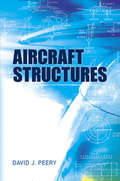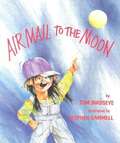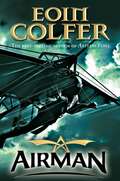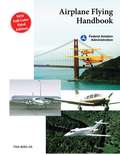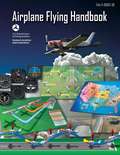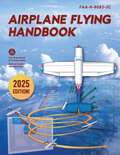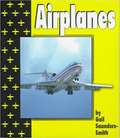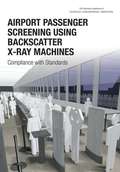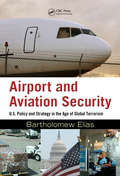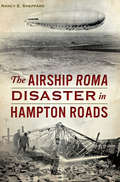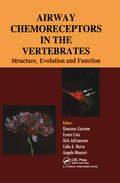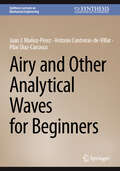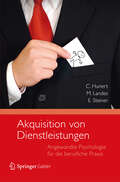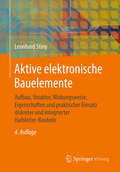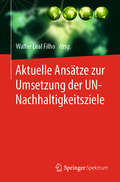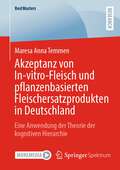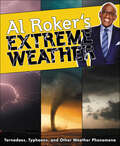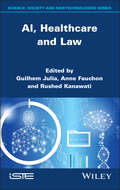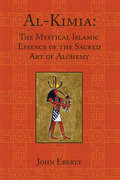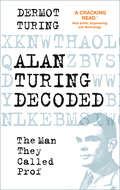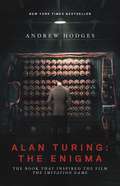- Table View
- List View
Aircraft Propulsion and Gas Turbine Engines, Second Edition
by Ahmed F. El-SayedAircraft Propulsion and Gas Turbine Engines, Second Edition builds upon the success of the book’s first edition, with the addition of three major topic areas: Piston Engines with integrated propeller coverage; Pump Technologies; and Rocket Propulsion. The rocket propulsion section extends the text’s coverage so that both Aerospace and Aeronautical topics can be studied and compared. Numerous updates have been made to reflect the latest advances in turbine engines, fuels, and combustion. The text is now divided into three parts, the first two devoted to air breathing engines, and the third covering non-air breathing or rocket engines.
Aircraft Structures (Dover Books on Aeronautical Engineering)
by David J. PeeryStill relevant decades after its 1950 publication, this legendary reference text on aircraft stress analysis is considered the best book on the subject. It emphasizes basic structural theory, which remains unchanged with the development of new materials and construction methods, and the application of the elementary principles of mechanics to the analysis of aircraft structures. Suitable for undergraduate students, this volume covers equilibrium of forces, space structures, inertia forces and load factors, shear and bending stresses, and beams with unsymmetrical cross sections. Additional topics include spanwise air-load distribution, external loads on the airplane, joints and fittings, deflections of structures, and special methods of analysis. Topics involving a knowledge of aerodynamics appear in final chapters, allowing students to study the prerequisite aerodynamics topics in concurrent courses.
Airmail to the Moon
by Tom BirdseyeWhen the tooth that she was saving for the tooth fairy disappears, Ora Mae sets out to find the thief and send him "airmail to the moon!"
Airman
by Eoin ColferAt the dawn of the age of flight, Conor Broekhart is a boy living on the Saltee Islands off the Irish coast, where his father works as the king's bodyguard. But his happy, carefree life is changed forever when he finds out that the power-hungry Marshall Hugo Bonvilain is organizing a military coup to overthrow the king. When Conor is unable to stop Bonvilain, the king is murdered, and Conor is falsely accused of the crime and thrown into prison. In prison, the boy passes the solitary months by scratching designs for flying machines onto his cell walls. After two years, Conor is finally able to build a glider, and executes a daring escape to the mainland where he works to revenge himself on Bonvilain, save his family and the woman he loves..
Airplane Flying Handbook (FAA-H-8083-3A)
by Federal Aviation AdministrationThe Federal Aviation Administration’s Airplane Flying Handbook provides pilots, student pi-lots, aviation instructors, and aviation specialists with information on every topic needed to qualify for and excel in the field of aviation. Topics covered include: ground operations, cockpit management, the four fundamentals of flying, integrated flight control, slow flights, stalls, spins, takeoff, ground reference maneuvers, night operations, and much more. The Airplane Flying Handbook is a great study guide for current pilots and for potential pilots who are interested in applying for their first license. It is also the perfect gift for any aircraft or aeronautical buff.
Airplane Flying Handbook: FAA-H-8083-3B (FAA Handbooks Ser.)
by Federal Aviation AdministrationThe Federal Aviation Administration’s Airplane Flying Handbook provides pilots, student pilots, aviation instructors, and aviation specialists with information on every topic needed to qualify for and excel in the field of aviation. Topics covered include:Ground operationsCockpit managementThe four fundamentals of flyingIntegrated flight controlSlow flightsStallsSpinsTakeoffGround reference maneuversNight operationsAnd much moreUpdated to include the most current information, the Airplane Flying Handbook is a great study guide for current pilots and for potential pilots who are interested in applying for their first license. It is also the perfect gift for any aircraft or aeronautical buff.
Airplane Flying Handbook: FAA-H-8083-3C (2024) (Faa Handbooks Ser.)
by Federal Aviation AdministrationTHE DEFINITIVE GUIDE TO AIRPLANE FLYING, DEVELOPED BY FAA EXPERTS FOR USE IN 2024 AND BEYOND The Federal Aviation Administration&’s official publication, Airplane Flying Handbook provides pilots, student pilots, aviation instructors, and aviation specialists with information on every topic needed to qualify for and excel in the field of aviation. Topics covered include: Flight Training Ground Operations Basic Flight Maneuvers Energy Management: Mastering Altitude and Airspeed Control Maintaining Aircraft Control: Upset Prevention and Recovery Training Takeoffs and Departure Climbs Ground Reference Maneuvers Airport Traffic Patterns Approaches and Landings Performance Maneuvers Night Operations Transitions to Complex, Light-Sport, Multiengine, Tailwheel, and Turbopropeller- and Jet-Powered Airplanes Emergency Procedures Updated in 2021 with the most current information, including an all-new chapter on energy management, the Airplane Flying Handbook is a great study guide for current pilots and for potential pilots who are interested in applying for their first license. With full-color illustrations, photos, and diagrams detailing every chapter, this is a one-of-a-kind resource for pilots and would-be pilots. It is also the perfect addition to any aircraft or aeronautical enthusiast's library.
Airplanes
by Gail Saunders-Smith"Summary: In simple text and photographs, describes several different kinds of airplanes, including paper airplanes, biplanes, and jets."
Airport Passenger Screening Using Backscatter X-Ray Machines: Compliance with Standards
by Committee on Airport Passenger Screening: Backscatter X-Ray MachinesPassenger screening at commercial airports in the United States has gone through significant changes since the events of September 11, 2001. In response to increased concern over terrorist attacks on aircrafts, the Transportation Security Administration (TSA) has deployed security systems of advanced imaging technology (AIT) to screen passengers at airports. To date (December 2014), TSA has deployed AITs in U. S. airports of two different technologies that use different types of radiation to detect threats: millimeter wave and X-ray backscatter AIT systems. X-ray backscatter AITs were deployed in U. S. airports in 2008 and subsequently removed from all airports by June 2013 due to privacy concerns. TSA is looking to deploy a second-generation X-ray backscatter AIT equipped with privacy software to eliminate production of an image of the person being screened in order to alleviate these concerns. This report reviews previous studies as well as current processes used by the Department of Homeland Security and equipment manufacturers to estimate radiation exposures resulting from backscatter X-ray advanced imaging technology system use in screening air travelers. Airport Passenger Screening Using Backscatter X-Ray Machines examines whether exposures comply with applicable health and safety standards for public and occupational exposures to ionizing radiation and whether system design, operating procedures, and maintenance procedures are appropriate to prevent over exposures of travelers and operators to ionizing radiation. This study aims to address concerns about exposure to radiation from X-ray backscatter AITs raised by Congress, individuals within the scientific community, and others.
Airport and Aviation Security: U.S. Policy and Strategy in the Age of Global Terrorism
by Bartholomew EliasThe response of the U.S. federal government to the events of September 11, 2001 has reflected the challenge of striking a balance between implementing security measures to deter terrorist attacks while at the same time limiting disruption to air commerce. Airport and Aviation Security: U.S. Policy and Strategy in the Age of Global Terrorism is a co
Airship ROMA Disaster in Hampton Roads, The (Disaster)
by Nancy E. SheppardIn March 1921, Major John G. Thornell and his crew were detailed to Italy to procure a new experimental airship for the United States Army Air Service. Stationed at Langley Field in Hampton, the ROMA never lived up to expectations despite being heralded as the future of military innovation. Tragically, it crashed and erupted in a ball of fire in 1922, claiming the lives of thirty-four of the brave men aboard. Author Nancy E. Sheppard reveals the forgotten, harrowing story of one of the last great airships and those who sacrificed for the promise of a new era in aviation.
Airway Chemoreceptors in Vertebrates
by Dirk Adriaensen Colin A. Nurse Giacomo Zaccone Ernest Cutz Angela MauceriThis book provides a comprehensive and up-to-date account of the information available on the morphological, physiological and evolutionary aspects of specialized cells distributed within the epithelia of the airways in the vertebrates. A lot of work has been done on the cell and molecular biology of these cells which are regarded as as oxygen receptor neuroepithelial cells. These chemoreceptors which were conserved throughout evolution have neuroendocrine functions carrying their signals to the central nervous system. The chemoreceptor cells are sensors which detect the signal changes in the external and internal environments, and play a key role in the survival of various species. Studies addressed to the chemoreceptor cell systems in the airways are of great importance for investigating their response to changes in the oxygen and carbon dioxide concentrations in the environment since the future of the planet earth is being threatened by global warming and climate change. Praise for the book: ...This volume would be of special interest to researchers who are curious about the evolution of vertebrate respiratory control in general and the regulation of ventilation in nonmammalian vertebrates in particular. -Wayne L. Silver, Wake Forest University, in The Quarterly Review of Biology, Volume 85, Number 2
Airy and Other Analytical Waves for Beginners (Synthesis Lectures on Mechanical Engineering)
by Juan J. Muñoz-Perez Antonio Contreras-de-Villar Pilar Diaz-CarrascoThe aim of this book is to become something practical, providing a description of the essential theory (explained simply) and many solved exercises. The basic concepts necessary to understand the rudiments of the Airy wave and other analytical waves (and their application to Coastal Engineering) are clarified. Moreover, the appropriate mathematical tools are given in certain cases because some science courses do not require a minimum background in mathematics or physics. Despite not going into depth into the theoretical developments, experience has demonstrated that students are ensured to acquire the bare minimum of knowledge necessary to pursue any subsequent improvement course.
Akquisition von Dienstleistungen: Angewandte Psychologie für die berufliche Praxis
by Miriam Landes Eberhard Steiner Claus HunertErfolgreiche Verkäufer fühlen sich meist als "die Könige" des Unternehmens und dies meist mit gutem Recht, denn sie sind es, die an vorderster Front für den Erfolg des Unternehmens sorgen. Schwierig genug ist diese Aufgabe schon, wenn man ein konkretes Produkt verkaufen soll, aber das bietet wenigstens den Vorteil, dass es der Kunde im wahrsten Sinne des Wortes begreifen, es testen und auf seine Erwartungen hin überprüfen kann, bevor er seine Kaufentscheidung trifft. Die besondere Herausforderung im Verkauf von Dienstleistungen liegt darin, dass man auf der "Klaviatur" der verschiedenen psychologischen Befindlichkeiten, Erwartungen, aber auch Ängste und situativer Besonderheiten auf Seiten seines Kunden zu spielen vermag. Aufgrund angewandter psychologischen Erkenntnisse bietet dieses Werk die nötigen Einblicke für die Praxis. Auch stellt es diese Klaviatur erstmals in umfassender Weise vor und bietet darüber hinaus konkrete Handlungsempfehlungen für unterschiedliche Verkaufssituationen. Somit ist es wertvolle und zugleich ansprechend interessante Lektüre für alle, die aus beruflichen oder privaten Gründen mehr über die psychologischen Hintergründe von Akquise, Verkauf und Kaufentscheidungen erfahren möchten.
Aktive elektronische Bauelemente: Aufbau, Struktur, Wirkungsweise, Eigenschaften Und Praktischer Einsatz Diskreter Und Integrierter Halbleiter-bauteile
by Leonhard StinyDas Werk bietet ein umfangreiches Wissen über diskrete und integrierte Bauelemente der Halbleitertechnik. Beim Entwurf elektronischer Schaltungen sind gründliche Kenntnisse über eingesetzte Bauelemente erforderlich, um sowohl technisch als auch wirtschaftlich beste Lösungen zu finden und fehlerfreie Produkte zu realisieren. Als Basis werden die theoretischen und physikalischen Grundlagen der Halbleitertechnik vermittelt. Für alle Halbleiter-Bauelemente werden Aufbau, Wirkungsweise, Kenngrößen, Eigenschaften und Charakteristiken erläutert. Mögliche Anwendungen werden unter Bezug auf die Praxis aufgezeigt. Das Buch kann im Studium, in der Lehre sowie als Nachschlagewerk in der Praxis verwendet werden.
Aktuelle Ansätze zur Umsetzung der UN-Nachhaltigkeitsziele
by Walter Leal FilhoDas Buch befasst sich mit den Themen Nachhaltigkeit und Nachhaltigkeitsziele der UN. Obwohl letztere schon 2015 verabschiedet wurden und die Umsetzung bis 2030 abgeschlossen sein soll, herrscht gegenwärtig noch immer ein Mangel an Initiativen, die die Nachhaltigkeitsziele zum Thema haben. Das Buch stößt eine Diskussion darüber an, wie das Thema Nachhaltigkeit ganzheitlich in der Lehre, Forschung, Wirtschaft und Gesellschaft eingeführt und bearbeitet werden kann. Eine Vielzahl unterschiedlicher Disziplinen, von den Sozial- und Wirtschaftswissenschaften über Mode- und Kunst- sowie Umweltwissenschaften bis hin zu den Sprach- und Medienwissenschaften tragen zu dem Werk bei. Im Fokus des Buchs stehen die Mittel und Wege, mit denen das Engagement der Hochschulen und Nichtregierungsorganisationen in den globalen Bemühungen zur Umsetzung der Nachhaltigkeitsziele zusammengeführt wird. Der Band vereinigt viele Erfahrungen und Fallstudien, die zur Weiterentwicklung des Themas „Umsetzung der SDGs“ beitragen.
Akzeptanz von In-vitro-Fleisch und pflanzenbasierten Fleischersatzprodukten in Deutschland: Eine Anwendung der Theorie der kognitiven Hierarchie (BestMasters)
by Maresa Anna TemmenMaresa Anna Temmen untersucht auf Grundlage der Theorie der kognitiven Hierarchie die Konsumbereitschaft für In-vitro-Fleisch und pflanzenbasierte Fleischersatzprodukte in Deutschland. Hierzu werden unter anderem ernährungspsychologische Einflussfaktoren genutzt, die sich auf moralische und ideologische Einstellungen zum Fleischkonsum beziehen. Die Ergebnisse der quantitativen Online-Fragebogenstudie zeigen, dass die Konsumbereitschaft für In-vitro-Fleisch und pflanzenbasierte Fleischersatzprodukte in der deutschen Bevölkerung relativ hoch ist und stützen die Theorie der kognitiven Hierarchie: Entsprechend können eine universalistisch geprägte Wertestruktur, eine geringe soziale Dominanzorientierung, eine geringe Ausprägung von Speziesismus und karnistischer Dominanz sowie eine geringe Unterstützung von Rechtfertigungsstrategien für den Konsum von Fleisch Gründe für eine hohe Konsumbereitschaft von In-vitro-Fleisch und pflanzenbasierten Fleischalternativen sein. Die Studie zeigt, dass tiefliegende Persönlichkeitsvariablen wie Werte und Wertorientierungen einen Einfluss auf spezifischere Einstellungen nehmen, die wiederum einen Einfluss auf die Konsumbereitschaft von Fleischalternativen haben.
Al Roker's Extreme Weather: Tornadoes, Typhoons, and Other Weather Phenomena
by Al RokerNew York Times bestselling author, award-winning meteorologist, and TodayShow co-anchor Al Roker explores extreme weather phenomena in his first book for kids. This middle grade book is an excellent choice for tween readers in grades 5 to 6, especially during homeschooling. It’s a fun way to keep your child entertained and engaged while not in the classroom. Dive deep into a world of fascinating weather with everyone’s favorite meteorologist, Al Roker!With this mesmerizing book that covers a wide range of topics, readers will learn about the conditions that generate unique weather occurrences like red sprites, thundersnow, and fogsicles.Surprising facts, colorful spreads, and captivating pictures will hook children and adults alike as they uncover the mysteries of extreme weather—some they never even knew existed!
Al, Healthcare and Law (ISTE Invoiced)
by Anne Fauchon Rushed Kanawati Guilhem JuliaIn a fully digitized world and hyper-connected society, artificial intelligence (AI) is developing more and more each day. In the aftermath of the Covid-19 pandemic, it seems appropriate to examine the real or imagined progress of AI in terms of human health. Like artificial intelligence, health is a field that involves a wide range of research disciplines. In order to better define and understand these social and technical developments, Al, Healthcare and Law brings together the thoughts and analyses of doctors, lawyers, economists and computer scientists. Through a wide range of original overviews of the issues involved, the book addresses questions such as the development of telemedicine, the use of medical data, the increased human perspective or medical ethics, and takes a multi-disciplinary and accessible approach to questioning the relationship between humans and computers, between the intimate and the machine.
Al-Kimia: The Mystical Islamic Essence of the Sacred Art of Alchemy
by John EberlyAl-Kimia - The Mystical Islamic Essence of the Sacred Art of Alchemy by John Eberly presents a condensed history of Alchemy told through concise biographies of early Sufi Masters, Chapters examine occult areas of alchemical and spiritual interest such as jafr, an exegetical Qur'anic science akin to Hebrew Qabala; the Qiyamat or 'Great Resurrection', of the heretical Ismaili sect; the contrary path of the saintly Malamatiyya or 'blameworthy ones'; Hermetic color theory, and 'hidden' art history. A glossary of transliterated terms is appended that will greatly help the beginner as well as the advanced student of these subjects. Al-Kimia is a sound scholarly treatment of the Islamic contribution to the art of alchemy, a rich compendium of Sufi, Shi'ite, and Hermetic lore, and a string of spiritual meditations so concentrated and poetic as to be 'operative', God-willing, on the subtle material of the reader's psyche. It even ends with a recipe fro an actual beginner's alchemical operation. In density and lucidity, a real 'gem'. Charles Upton, author of The System of Antichrist The appearance of John Eberly's consummate Al-Kimia: The Mystical Islamic Essence of the Sacred Art of Alchemy is indeed cause for celebration. Readers already devoted to alchemical research are rewarded by Eberly's lucid presentation of the great adepts and their relationship to the various lineages and schools. For those less familiar with the Sacred Art, in this time of ever heightening crisis, Eberly's text provides an urgently needed opportunity to appreciate the rich and diverse history and culture of the Islamic world. Jay Bremyer, author of The Dance of Created Lights: A Sufi Tale
Alabama Grade 7 Prentice Hall Science Explorer
by Cyr Padilla MiaoulisLead author Michael Padilla once again sets the standard for engaging, hands-on science exploration. Correlates to Alabama state standards.
Aladdin's Lamp
by John FreelyAladdin’s Lamp is the fascinating story of how ancient Greek philosophy and science began in the sixth century B.C. and, during the next millennium, spread across the Greco-Roman world, producing the remarkable discoveries and theories of Thales, Pythagoras, Hippocrates, Plato, Aristotle, Euclid, Archimedes, Galen, Ptolemy, and many others. John Freely explains how, as the Dark Ages shrouded Europe, scholars in medieval Baghdad translated the works of these Greek thinkers into Arabic, spreading their ideas throughout the Islamic world from Central Asia to Spain, with many Muslim scientists, most notably Avicenna, Alhazen, and Averroës, adding their own interpretations to the philosophy and science they had inherited. Freely goes on to show how, beginning in the twelfth century, these texts by Islamic scholars were then translated from Arabic into Latin, sparking the emergence of modern science at the dawn of the Renaissance, which climaxed in the Scientific Revolution of the seventeenth century.
Alan M. Turing
by Sara TuringTuring's reputation has grown, as his contributions to logic, mathematics, computing, and artificial intelligence have become better appreciated. This republication of his mother's biography is enriched by a never-before-published memoir by Alan's older brother.
Alan Turing Decoded: The Man They Called Prof
by Dermot Turing‘A cracking read. ’Nick Smith, Engineering and TechnologyAlan Turing was an extraordinary man who crammed into his 42 years the careers of mathematician, codebreaker, computer scientist and biologist. He is widely regarded as a war hero grossly mistreated by his unappreciative country, and it has become hard to disentangle the real man from the story. It is easy to cast him as a misfit, the stereotypical professor. But actually Alan Turing was never a professor, and his nickname ‘Prof’ was given by his codebreaking friends at Bletchley Park. Now Dermot Turing has taken a fresh look at the influences on his uncle’s life and creativity, and the creation of a legend. He discloses the real character behind the cipher-text, answering questions that help the man emerge from his legacy: how did Alan’s childhood experiences influence him? How did his creative ideas evolve? Was he really a solitary genius? What was his wartime work after 1942, and what of the Enigma story? What is the truth about the conviction for gross indecency, and did he commit suicide? In Alan Turing Decoded, Dermot’s vibrant and entertaining approach to the life and work of a true genius makes this a fascinating and authoritative read.
Alan Turing: The Book That Inspired the Film The Imitation Game - Updated Edition
by Andrew HodgesA NEW YORK TIMES BESTSELLERThe official book behind the Academy Award-winning film The Imitation Game, starring Benedict Cumberbatch and Keira KnightleyIt is only a slight exaggeration to say that the British mathematician Alan Turing (1912–1954) saved the Allies from the Nazis, invented the computer and artificial intelligence, and anticipated gay liberation by decades—all before his suicide at age forty-one. This New York Times bestselling biography of the founder of computer science, with a new preface by the author that addresses Turing&’s royal pardon in 2013, is the definitive account of an extraordinary mind and life.Capturing both the inner and outer drama of Turing&’s life, Andrew Hodges tells how Turing&’s revolutionary idea of 1936—the concept of a universal machine—laid the foundation for the modern computer and how Turing brought the idea to practical realization in 1945 with his electronic design. The book also tells how this work was directly related to Turing&’s leading role in breaking the German Enigma ciphers during World War II, a scientific triumph that was critical to Allied victory in the Atlantic. At the same time, this is the tragic account of a man who, despite his wartime service, was eventually arrested, stripped of his security clearance, and forced to undergo a humiliating treatment program—all for trying to live honestly in a society that defined homosexuality as a crime.The inspiration for a major motion picture starring Benedict Cumberbatch and Keira Knightley, Alan Turing: The Enigma is a gripping story of mathematics, computers, cryptography, and homosexual persecution.

